In the early and last parts of the year, the weather in the northeastern portion of Luzon Island is bracing, with the wind making it nippy, much welcome in a tropical country that gets unbearably warm during the large part of the year. The province of Isabela takes advantage of this weather to hold what has arguably become the largest event in the Cagayan Valley Region.
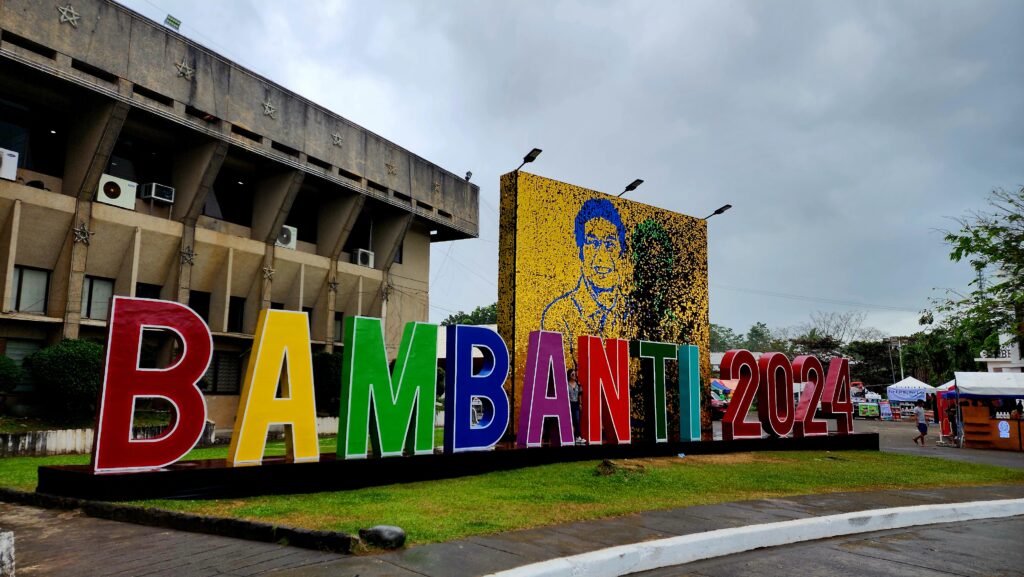
The Bambanti Festival is an annual celebration of everything Isabeleño, showcasing the culture, food, tourist attractions and agricultural products, among others, of the sprawling province. It is one of the numerous modern-day festivals in the Philippines, created by local governments, social and promotional in intent, marked by parades and dancing inspired by the Brazilian Carnival, aimed at boosting business and tourism, themed according to local traditions or cultural symbols often made spectacular and made up of several events such as fairs, street dancing, beauty pageants and different contests.
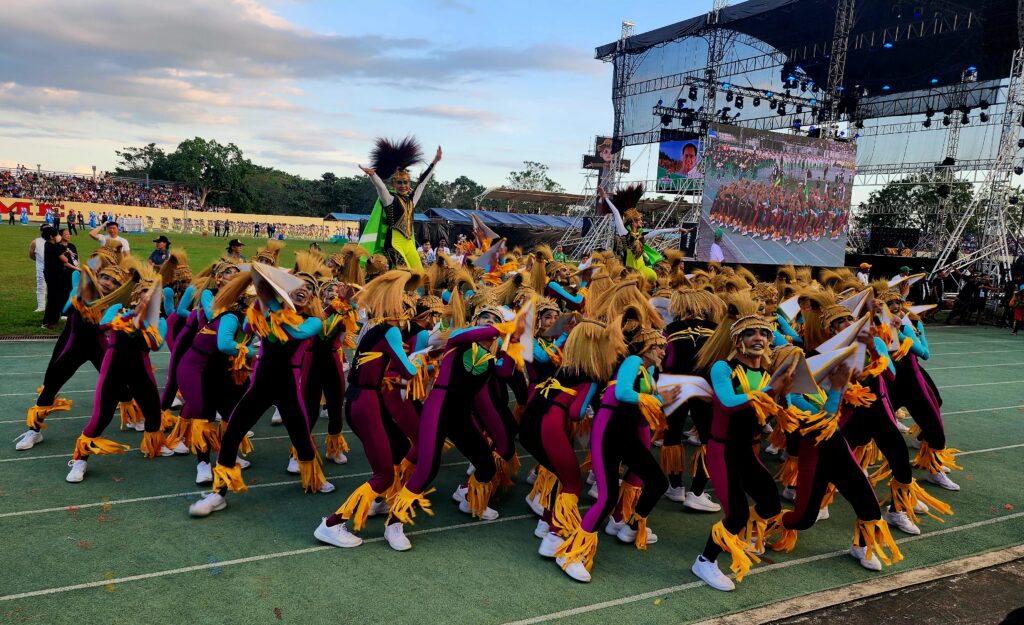
According to festival director Nilo Agustin, veteran tourism worker and events conceptualizer and organizer, the Bambanti Festival started when the national tourism campaign, Wow Philippines, was launched in early 2000s, and then it was revived in 2011 to revitalize tourism in Isabela. It took the scarecrow, called bambanti in Ilocano, the dominant language and lingua franca in northern Philippines, as its inspiration, noting that it is a common object in the agricultural province. For the festival, the farm icon, made to scare birds that feed on crops, is construed as a protector and a guardian. While scarecrows are rarely used nowadays, they come alive in different forms and interpretations during this time — giant ones in different materials at the fair, a towering digital cartoon version during the showdown, dancers with scarecrow-inspired costumes and movements.
Another factor that influences the events and other creative endeavors is the year’s thematic message or slogan. For 2024, it was ostensibly tourism-oriented — “Ettam ngana ta Isabela,” which means “let’s go to Isabela” or “come to Isabela” in Ibanag, one of the languages of the region — meant to be an invitation to explore the province.
Exploring the province, one can start with this festival. The week, from 22 to 27 January, was packed to brim with shows, parties, parades, sports tournaments, a fair, a cooking contest, street dancing competition and a beauty pageant, among others, organized by the provincial government led by governor Rodolfo Taguinod Albano III and vice governor Faustino “Bojie” Dy III, who served as the festival’s director general, and their partners. Most of these events were held at the Isabela Provincial Capitol Compound in the barangay of Alibagu of the capital, Ilagan City, where vendors also converged
and a makeshift tiangge emerged at the fringes.
Solemn and rousing start
The festival officially began with a thanksgiving Mass at the Cathedral of Saint Michael the Archangel in Gamu, attended by the province’s officials and celebrated by Reverend Father Ric-Zeus Angobung, who said that the festival symbolized resilience, creativity and unity of the people of Isabela.
The Mass was followed by an opening ceremony, the start of the Agri-Ecotourism Exhibit and Sale at the Bambanti Village and the i-Run for Youth Center: A 5K Fun Run and Rave Party for a Cause, where 13,245 people registered to participate to raise funds for a center for youth development. The run was preceded by a Zumba session and ended with a party.
Music and shows
Almost nightly, the festival held shows at the Queen Isabela Park for its music festival component that included “Harana Isabela,” featuring Arthur Miguel and local band MaryaKlara; “Isabela Jamfest,” featuring Comic Superstition, DJ Inna Gita and the cast of FPJ’S Batang Quiapo; “Banda Roon, Banda Dito,” featuring SunKissed Lola with local bands Pulse Melody and Lawis; and “Retro-Z Party,”
featuring DJ Dom and Pulse Melody.
Two major musical events were held at the Isabela Sports Complex in the last days of the festival — “Ettam Ngana: Kamangha-Mangha, Kahanga-Hangang Isabela,” featuring Julie Anne San Jose, Thea Astley, Jessica Villarubin, Nic Galano, Rex Baculfo, Jeremiah Tiangco and Jake Gacang, together with the Whiplash Dance Company; and the Isabela Grand Concert Party, featuring Morisette and
The Juans.
Bambanti Village and Agri-Ecotourism exhibit and sale
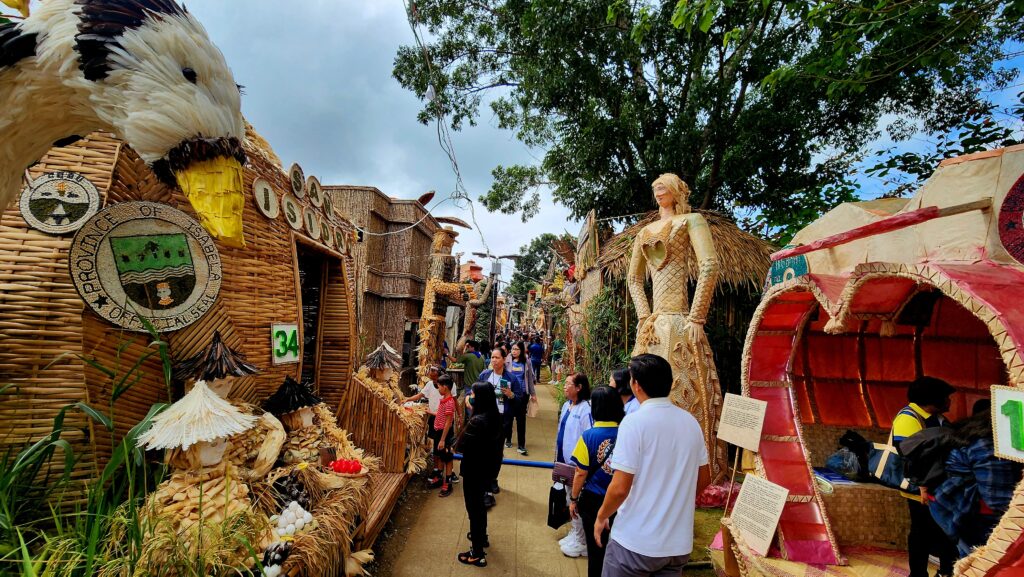
The Bambanti Village and the Agri-Ecotourism Exhibit and Sale ran for the duration of the festival, attracting crowds to the booths of the province’s different municipalities and cities.
Highlighting the towns’ icons, the booths were constructed mostly of a variety of locally sourced materials, mostly natural, making manifest the inventiveness of the designers and makers. Booths also came up with their own versions of the bambanti and lit up at night, making them more attractive. They also showcased the products, attractions and heritage of the different towns, very informative especially for visitors from other places.
There was a competition for the best booths and bambantis. Echague emerged as the winner in the Category A (for cities and first-class municipalities) of the Agri-ecotourism Booth with Ilagan City placing second and Cauayan City third. Meanwhile in Category B (for second-, third-, fourth- and fifth-class municipalities), Cordon won the first place while San Pablo made it to second place and Quirino third.
In the Giant Bambanti portion of the contest, the winners were Ilagan City (first), Echague (second) and San Mariano (third) in Category A, and Cordon (first), Burgos (second) and Delfin Albano (third) in Category B.
Festival King and Queen Costumes Competition
Another vehicle to show local creativity was the Festival King and Queen Costumes Competition. The festival king and queen serve as leads in the street dancing competition and their costumes are more spectacular. Usually made of local and natural materials, the costumes are tributes to the towns’ heritage, cultures and festivals.
A separate competition, focusing on design, was held for these costumes. Entries were put on exhibit at the Isabela Provincial Capitol Amphitheater, before being worn, paraded and judged on 25 January.
The town of Ramon clinched first places in both the Festival King Costume and Festival Queen Costume portions in Category B, followed by San Agustin in second and Luna in third, also in both portions.
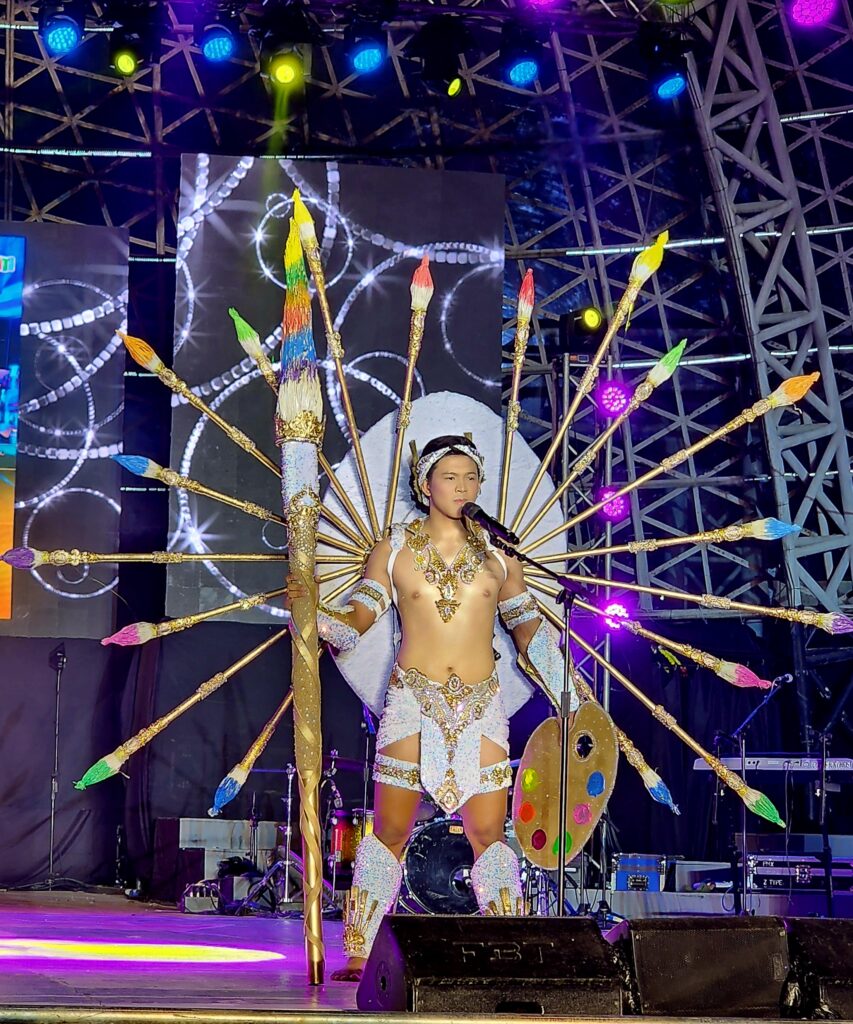
Designed by Michael Angelo Guiang, the dramatic Ramon entries consisted of traditional attires of the Gaddang, an indigenous group in Isabela, and large representations of a cobra and a crocodile, worn at the back.
Meanwhile in Category A, the town of Jones won first place both the Festival King Costume and Festival Queen Costume portions, followed by Alicia in second place, also for both portions, and Echague in third for Festival King and Santiago City in third for Festival Queen.
Designed by Danny Ross Trinidad, the Jones costumes were inspired by the town’s Pinilisa Festival, which highlights the red rice cultivated in Jones. Leaning towards traditional attire, and made up mostly of woven bamboo and nito vines and dried rice stalks, the costumes depicted the farming and harvesting of rice.
Queen Isabela
Queen Isabela was also a popular event, as beauty pageants are very much part of Philippine festivities. This year, 28 contestants vied for the crown during coronation night on 24 January at the Queen Isabela Park, where they were introduced in their creative costumes, which paid tribute to their towns’ and cities’ cultures, heritage and festivals and were made on display in an exhibit at the Northstar Mall in Alibagu days before the finals.
Contestants competed in casual wear designed by Albert Andrada and swimwear from Ricky Abad. By the end, Kristine Joy Guzman of Ilagan City emerged as the grand winner. Also, Precious Faith Mirasol of Santa Maria was crowned Queen Isabela Tourism, while Jhudiel Eunisse Taguinod of Echague Queen Isabela Culture and the Arts. Rounding up the winners’ court were first runner-up Grace Esther Due of Roxas and second runner-up Alexis Ann Ramos of Cauayan City.
The top 10 finalists included Maria Cristina Ysabela Caliguiran of Tumauini, Ara Joy Pasicolan of San Mateo, Francheska Andrea Servan of Alicia, Alain Mariel Bagunu of Cabagan and Maira Odessa Ignacio of Cordon.
‘Makan ken Mainum ti Isabela’
Food is a staple of festivities, and Isabela has a number of interesting dishes and sweets that await appreciation by more people. The Bambanti Festival has become a way for visitors to discover the province’s culinary heritage as well as a venue to spark food ideas through the Makan ken Mainum ti Isabela (Food and Drinks of Isabela), a free-style cooking and beverage mixing competition now on its eighth year. Spearheaded by chef Mary Ann Arcega-Dy, it was one of the activities at the Bambanti Village.
Organizers aimed “to encourage Isabeleños to discover new dishes and beverages that shall be introduced in the local restaurants, hotels and resorts in the Cagayan Valley and eventually all over the Philippines.”
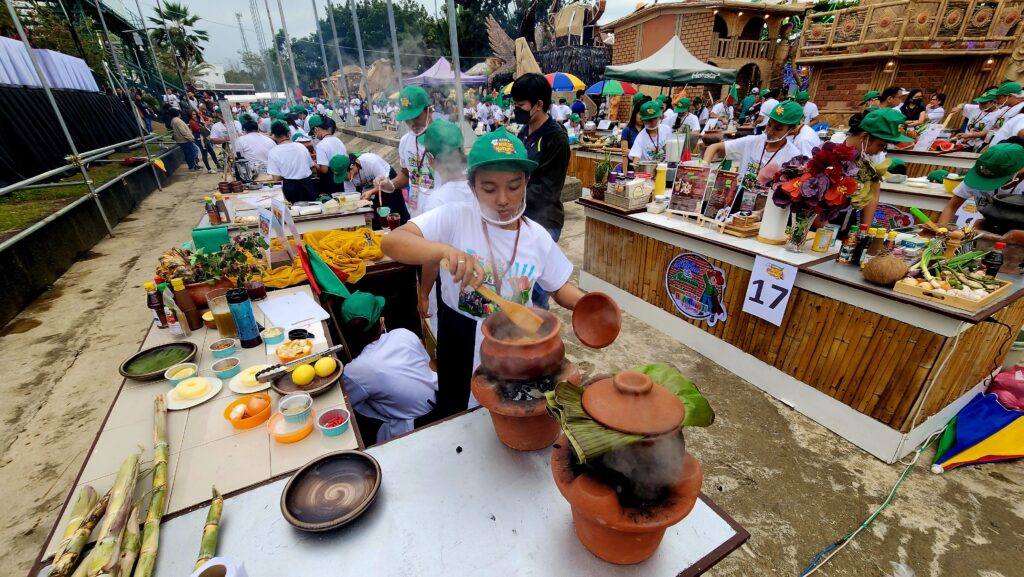
On 25 January, 25 groups of young cooks, aged 15 to 24 years, representing their municipalities or cities, prepared dishes and drinks on the spot for a set time. The theme for this year was “Biggang ken Banga,” highlighting the use of live coals and traditional earthen pots. Their outputs were judged according to taste, including the use of Isabela produce and emphasis on Philippine flavors, visual appeal, including the use of safe, environment-friendly and functional packaging, and originality and
creativity.
The winners in the Mainum ti Isabela category were the groups from Dinapigue (first), Santiago City (second), Cordon (third), Tumauini (fourth) and Echague (fifth), while in the Makan ti Isabela category, winners were groups from Dinapigue (first), Santiago City (second), Luna (third), Cordon (fourth) and Tumauini (fifth).
Street Dance and Festival Dance Showdown Competition
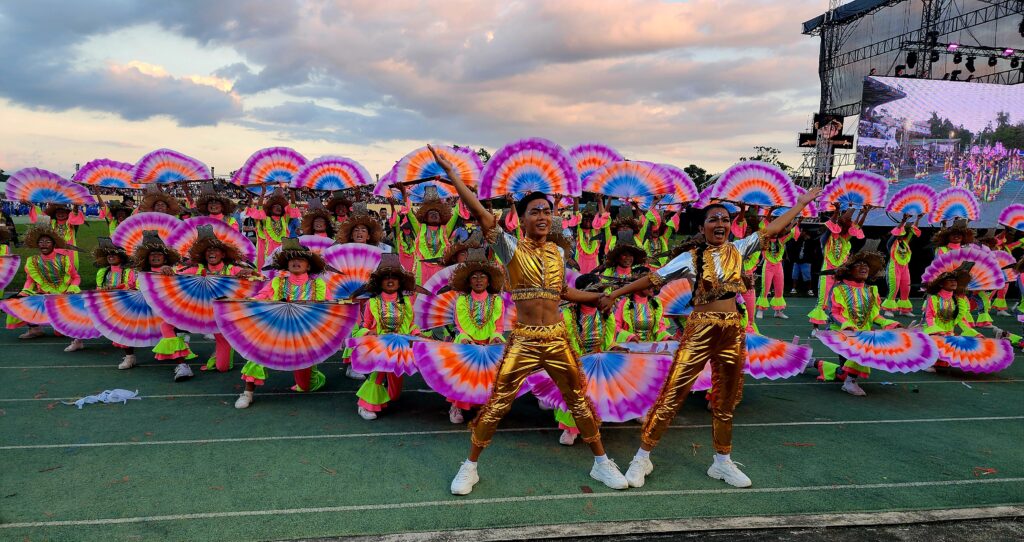
The street dancing and showdown serves as highlight in most festivals in the country, and in Bambanti Festival, it was a culmination of the whole celebration, with 1,600 dancers from 16 municipalities and cities enthralling the audience gathered at the Isabela Sports Complex.
In eye-catching costumes, they paraded and danced around the running track, executing the signature festival movements depicting the scarecrow as well as the different touristic festivals in the province — Hilada Festival of Dinapigue, Mengal Festival of Echague, Balamban Festival of Santiago City, Pinakbet Festival of Roxas, Pagay Festival of Alicia, Gawagaway-yan Festival of Cauayan City, Mammangi Festival of Ilagan City, Pinilisa Festival of Jones, Masetas Festival of Reina Mercedes, Baraniw Festival of Quirino, Tilapia Festival of Ramon, Nuang Festival of San Agustin, Gakit Festival of Angadanan, Kankanen Festival of Cabatuan, Mabanga Festival of Santa Maria and Bato Art Festival of Luna — all ending into an exhilarating dance showdown. Here, they employed lesser big backdrops and props, unlike in other festivals, and instead concentrated on choreography.

The grand program ended with the awarding of winners. The winners in the Festival King and Queen competitions, in Category B, were Quirino (first), Luna (second) and Santa Maria (third), while in Category A, the winners were Echague (first), Alicia (second) and Santiago City (third).
The Santa Maria group’s performance clinched for them the first place in both the Street Dance and Dance Showdown competitions (Category B). Meanwhile, the Jones contingent won the first place in Street Dance Category A, while Alicia reigned in Dance Showdown Category A, reclaiming the title after six years.
Other street dance winners were Cabatuan (second) and Quirino (third) in Category B and Alicia (second) and Echague (third) in Category B. In the dance showdown portion, other winners were Quirino (second) and Luna (third) in Category B, and Echague (second) and Jones (third) in Category A.
The town of Echague was declared the overall winner of the festival for their remarkable showings in different events while Quirino was proclaimed as first runner-up, Alicia second runner-up, Jones third runner-up and Luna fourth runner-up. The winners won fundings for their preferred projects.
Fireworks aptly punctuated the conclusion of the festival that harnessed the creativity and competitive spirit of the province.
